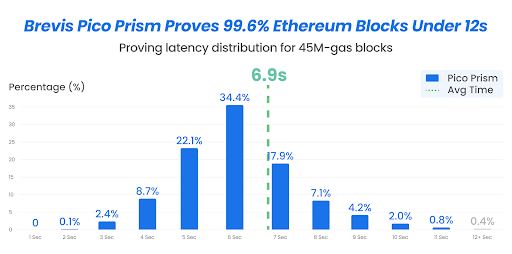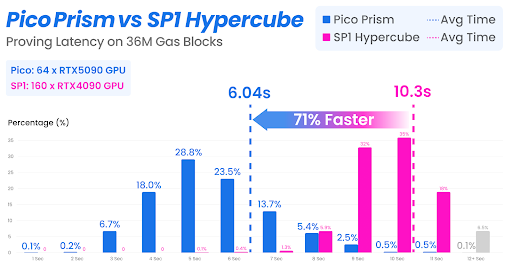Announcing Pico Prism, the state-of-the-art zkVM for Ethereum real-time proving. 99.6% of blocks proven under 12 seconds, 6.9s average with 64 RTX 5090 GPUs.
This marks a major step toward scaling Ethereum by 100x and a future where you can validate the chain from a phone.
This marks a major step toward scaling Ethereum by 100x and a future where you can validate the chain from a phone.

When tested on 36M-gas limit blocks used in the previous state-of-the-art benchmarks, Pico Prism delivered substantial performance improvements across all metrics:
- Coverage <10s: 98.9% vs 40.9%
- Hardware cost: $128K vs $256K (50% reduction)
- Average proving time: 6.04s vs 10.3s
- 3.4x better performance efficiency
- Coverage <10s: 98.9% vs 40.9%
- Hardware cost: $128K vs $256K (50% reduction)
- Average proving time: 6.04s vs 10.3s
- 3.4x better performance efficiency

Here's why crossing these thresholds matters for Ethereum's scaling roadmap.
Currently, every validator re-executes every transaction to verify blocks. This requires expensive hardware and creates a fundamental bottleneck: more transactions means more work for every validator.
Real-time proving breaks this model. One prover generates a proof, everyone else verifies it in milliseconds. The @ethereum community laid out this vision in their recent roadmap, and Pico Prism demonstrates it's now technically feasible at production scale.
blog.ethereum.org/2025/07/10/rea…
Currently, every validator re-executes every transaction to verify blocks. This requires expensive hardware and creates a fundamental bottleneck: more transactions means more work for every validator.
Real-time proving breaks this model. One prover generates a proof, everyone else verifies it in milliseconds. The @ethereum community laid out this vision in their recent roadmap, and Pico Prism demonstrates it's now technically feasible at production scale.
blog.ethereum.org/2025/07/10/rea…
Brevis Pico Prism is the distributed, multi-GPU evolution of our Pico zkVM. The architecture enables parallel proving across highly optimized pipelines, delivering near-linear acceleration across multiple machines.
Reach out to us for collaboration: form.typeform.com/to/lduiliob?ty…
Reach out to us for collaboration: form.typeform.com/to/lduiliob?ty…
All benchmarks are fully reproducible. With binaries available at .
We're committed to contributing to transparent benchmark initiatives led by @eth_proofs that advance Ethereum's technical roadmap.github.com/brevis-network…
We're committed to contributing to transparent benchmark initiatives led by @eth_proofs that advance Ethereum's technical roadmap.github.com/brevis-network…
We're continuing to optimize Pico Prism with a focus on reducing hardware costs and power consumption. Our roadmap targets achieving the Ethereum Foundation's goals of sub-$100K capex and sub-10kW power draw in the coming months while maintaining performance.
blog.brevis.network/2025/10/15/pic…
blog.brevis.network/2025/10/15/pic…
• • •
Missing some Tweet in this thread? You can try to
force a refresh






